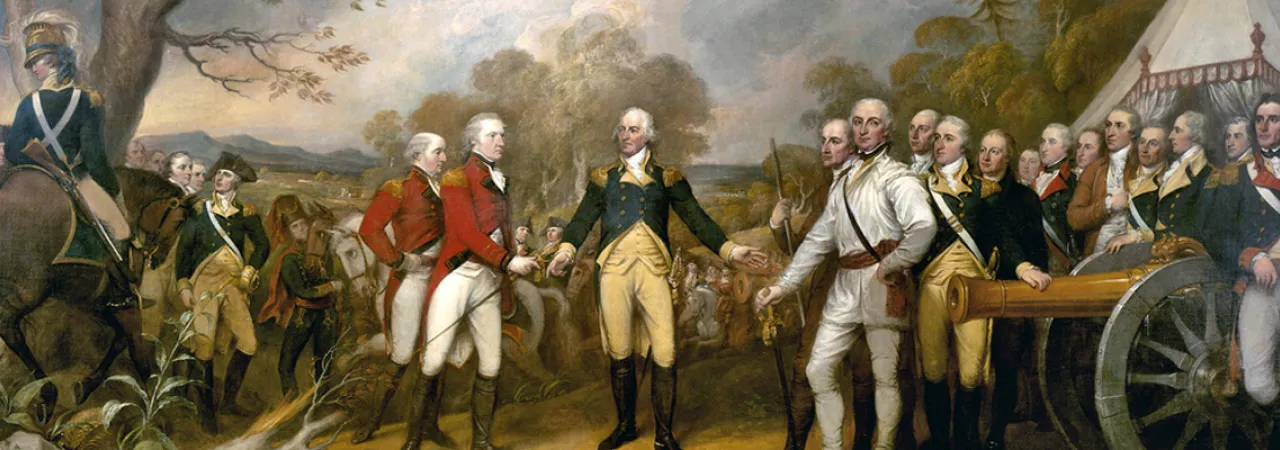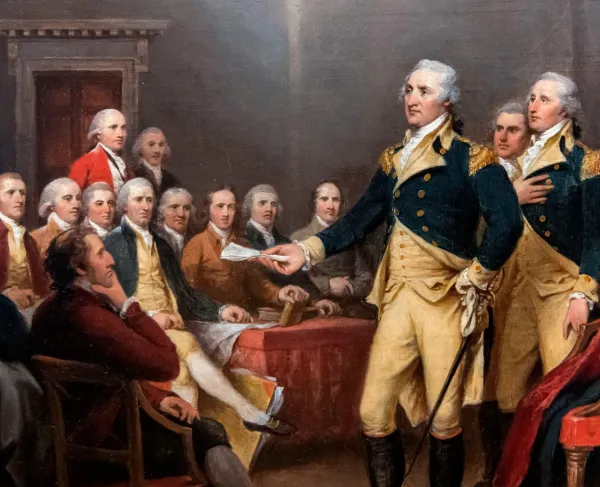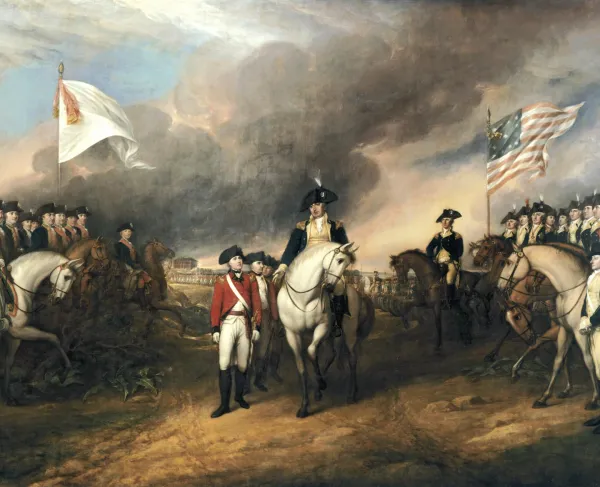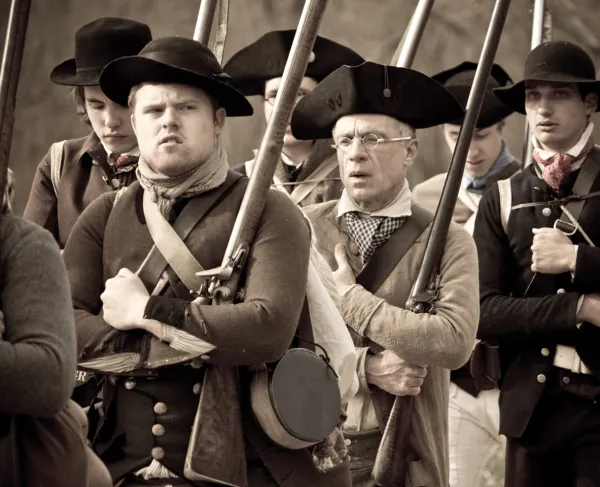In the spring of 1777, the British were looking to find a way to subdue the American rebels. In 1776, the British had been successful in capturing New York City and drove George Washington’s army across New Jersey, before the battles of Trenton and Princeton turned the tide in America’s favor and forced the British Army under General William Howe back into New York City. As Howe debated an attack on the American capital of Philadelphia, British General John Burgoyne proposed a three-pronged attack on the city of Albany in upstate New York to cut the New England colonies away from those south and west of the Hudson River. Lord Germain, the British Minister in charge of the war, gave Burgoyne permission to begin his campaign in the spring of 1777.
The campaign would be fraught with issues almost immediately as Germain’s orders were poorly communicated. While Germain approved Burgoyne’s plan with the thought that Howe would support him in some way, he also approved Howe’s plan to attack Philadelphia. However, part of Burgoyne’s plan relied on Howe at least fainting an attack up the Hudson River from New York City. In addition to this confusion about the role Howe was to play, Burgoyne and Howe had a contentious relationship, portending disaster.
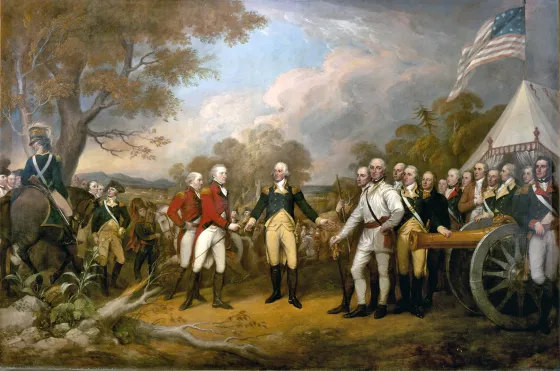
Burgoyne moved his army of 7,000 British redcoats, German auxiliaries, Loyalists, and Native American allies out of Canada in June of 1777. Burgoyne’s army sailed down Lake Champlain and captured the undefended Crown Point fort. In early July, Burgoyne began to engage elements of American General Arthur St. Clair’s 3,000 men at Fort Ticonderoga. On the night of July 5, St. Clair retreated from Fort Ticonderoga and the following morning Burgoyne’s army captured this important strategic fort between Lake Champlain and Lake George.
Most of St. Clair’s men retreated through present-day Vermont and on July 7, 1777, elements of Burgoyne’s army attacked the rear guard of the Americans at Hubbardton. The fighting was fierce and bloody, and the Americans, though fighting well, were driven from the field. Despite losing the battle, the battle at Hubbardton allowed the main American Army to escape from Burgoyne and those troops would prove invaluable in the coming months for the Patriot cause. On July 8, 1777, an isolated detachment of British troops near Fort Anne was almost destroyed by a larger Patriot force. Only after running low on ammunition and with fear that British reinforcements were arriving did the American forces continue to fall back south. Despite losing both these battles, the Americans fought bravely.
After his victories at Ticonderoga, Hubbardton, and Fort Anne, Burgoyne decided to march overland to Fort Edward. This proved to be a consequential decision. During their march, American General Philip Schuyler attempted to make the British march from Skenesborough as difficult as possible by felling trees and destroying bridges. From Fort Anne to Fort Edward, the British had to cut a road through the dense wilderness. The march ended up taking Burgoyne nearly a month.
As Burgoyne’s army trudged through the New York wilderness, the second prong of the British invasion ran afoul. Colonel Barry St. Ledger and 1,600 British, Loyalist, and Native American troops sailed from Montreal to Lake Ontario and disembarked at Fort Oswego in western New York on July 25, 1777. They marched east towards Albany. Between St. Ledger and Albany was Fort Stanwix, which was held by Colonel Peter Gansevoort and 750 Americans. The British and Native Americans laid siege to the small fort on August 3, 1777. On August 6, 1777, a column of Patriot militia under the command of Colonel Nicholas Herkimer marched to the relief of the besieged Americans at Stanwix. Many of the Native Americans on the British side laid an ambush for this relief column at Oriskany, six miles away. The Battle of Oriskany was incredibly bloody and swayed back and forth. Eventually, the British forces fell back, but so did the relief column. However, when the British learned that American General Benedict Arnold and 900 Continentals were dispatched to relieve Fort Stanwix, the Native Americans with St. Ledger abandoned him. St. Ledger had no choice but to break off his siege on August 22, 1777, and fall back to Fort Oswego. The second prong of Burgoyne’s had been stopped in its tracks.
Meanwhile, Burgoyne and his force had arrived at Fort Edward. In early August, German Lieutenant Colonel Friedreich Baum received permission from Burgoyne to take a force of 800 German, British, and Loyalist soldiers east of the main army to forage for better horses for his dragoons. Baum’s men traveled towards the area near Bennington in New Hampshire. In New Hampshire, militia Colonel John Stark gathered a force of 1,500 militiamen from all around New England. On August 15, 1777, Baum had many of his men fortify the top of a hill and sent for reinforcements. The next morning Stark attacked Baum’s position. The fighting was fierce and deadly. Baum and the Germans on the top of the hill fought bravely, but ultimately were defeated by Stark’s men and Baum was mortally wounded. As the remnants of Baum’s men fled from the field, reinforcements for the Germans and British arrived, but too late. They fought more that day, but the arrival of more American troops pushed the British forces back. The Battle of Bennington proved to be a costly error for Burgoyne, and he lost nearly 1,000 men as a result.

In the American camp in August, Congress replaced General Philip Schuyler with General Horatio Gates. His army numbered about 7,000 men and was encamped on a bluff on the west side of the Hudson River just south of Saratoga, New York. This bluff, known as Bemis Heights, was a strong position and fortified by the Americans. Burgoyne learned of the failure of St. Ledger and the fact that Howe had departed on his attempt to capture Philadelphia. Burgoyne was now the only column heading to Albany. In September, he and his now 6,000 man army crossed to the west side of the Hudson and began marching towards Gates at Saratoga.
On September 19, 1777, Burgoyne began advancing slowly towards Gates's position. Benedict Arnold requested permission from Gates to attack the advancing British. Gates allowed it. Arnold, along with Daniel Morgan, struck the British vanguard at Freeman’s Farm. The fighting was brutal, and Arnold asked Gates for reinforcements. Gates refused and ordered Arnold to fall back. Only when German troops came to help the British soldiers were the Americans forced back. The day ended with hundreds of losses on both sides. The two sides remained encamped in front of each other following the bloody fighting.
After the fighting at Freeman’s Farm, Burgoyne received a letter from General Sir Henry Clinton that he was going to attempt to create a diversion to help Burgoyne by attacking American troops in the lower Hudson valley closer to New York City. While Clinton was successful in capturing the American Forts Montgomery and Clinton, by the time news reached the Americans and British at Saratoga, it was too late.
As Burgoyne’s Native American allies and Loyalists began abandoning his army, and as they began to run out of food and supplies, Burgoyne decided he would make an attempt to find the left flank of Gates’ army stationed at Bemis Heights. Gates, jealous of Arnold’s success at Freeman’s Farm, failed to mention his actions in the after-action report of the battle. Arnold and Gates wrote heated letters back and forth. When General Benjamin Lincoln arrived in the camp, Arnold was no longer Gates' defacto second in command as Lincoln outranked the Connecticut native. Arnold wrote to Gates that he planned on leaving Gates’ army to join Washington. Officers petitioned Arnold to stay with the army, and it seems that Arnold and Gates buried the hatchet long enough to see out the remainder of the campaign. On October 7, 1777, British and German soldiers under the command of British General Simon Fraser advanced towards Bemis Heights. Seeing the British advance, Arnold begged Gates to be allowed to engage with the enemy. At first, Gates sat silently, when pressed, the commander told Arnold that he was worried about Arnold's intentions. Arnold assured Gates that he could trust him, and with the blessing of his commander, Arnold began engaging with Burgoyne. The battle quickly evolved as fighting broke out in Barber's wheatfield. The British forces were stunted by ferocious firing from Daniel Morgan’s riflemen. Arnold rode to the front and began directing men in the battle. The British began to fall back towards Freeman’s Farm and the fortifications they had there. As General Fraser tried to rally the British soldiers, an American rifleman mortally wounded him in the stomach. The British forces fell back to two fortifications: the Balcarres (Light Infantry) Redoubt and Breymann Redoubt. Arnold, wanting to push the attack, shouted at the Americans to push forward. The Americans charged the redoubts. After a few advances, the Americans were successful in capturing the Breymann Redoubt. While assaulting the Breymann redoubt Arnold received a musket ball in his left leg. The fighting was over for the day, but the British had lost almost 600 men in the battle and it left Burgoyne’s army in an untenable position.
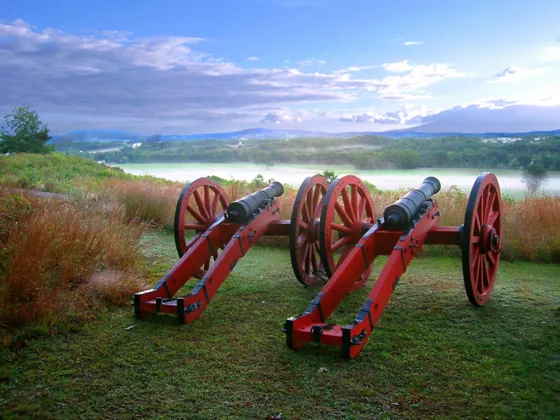
Burgoyne and his 5,000 man army fell back towards Saratoga (modern-day Schuylerville) and was surrounded by Gates’ army. On October 13, 1777, Burgoyne offered to open negotiations with Gates. After a couple of days of negotiating, Burgoyne agreed to surrender with the condition that his men would be paroled and return to England. On October 17, 1777, Burgoyne and his 5,000 man army officially surrendered to Gates. This was the first British Army to surrender in world history.
The successful conclusion for the Americans in the Saratoga campaign marked a major turning point in the Revolutionary War. While it succeeded in preventing Burgoyne’s plan of severing the American colonies into two, more importantly, it demonstrated to foreign powers that the United States had a legitimate chance to defeat the British. Shortly after learning of the victories at Saratoga, France recognized the independence of the new United States and entered into a military alliance with the Americans. With the American war now broadened into a global war with European superpowers, British strategy was altered for the remainder of the war. The entry of France into the war forced the British to divert manpower and resources to points all across the globe, it forced them to abandon Philadelphia, and it gave the Americans access to desperately needed sea power, manpower, and materiel that would ultimately result in a successful conclusion of the Revolutionary War and the establishment of a new nation.
Further Reading:
- Saratoga: Turning Point of America's Revolutionary War By: Richard Ketchum.
- With Musket & Tomahawk Volume I: The Saratoga Campaign and the Wilderness War of 1777 By: Michael O. Logusz
- The Compleat Victory: Saratoga and the American Revolution By: Kevin J. Weddle.
Related Battles
70
907
330
1,135
